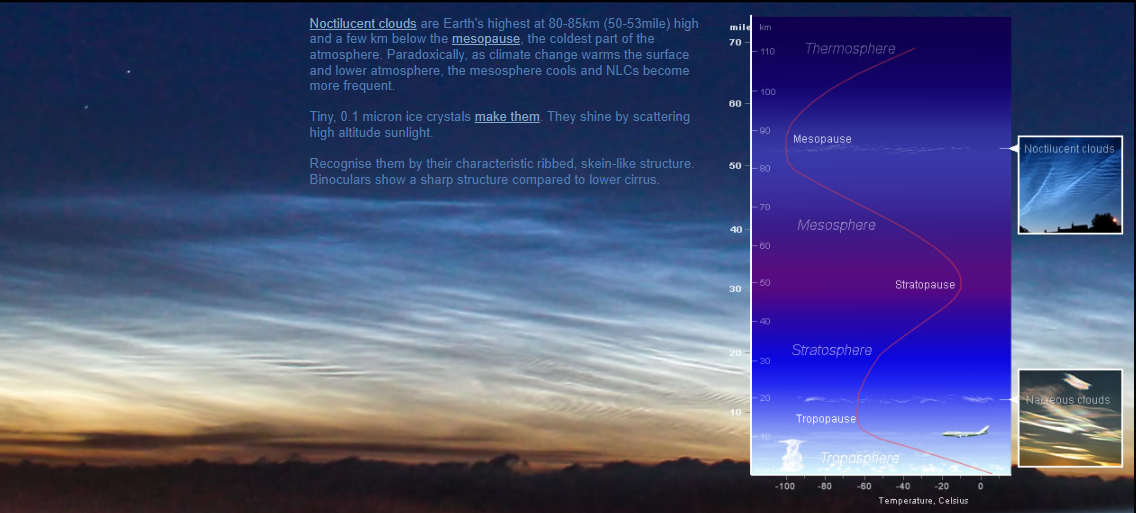NLCs, Noctilucent Clouds, Oxfordshire, England - OPOD
NLCs, Noctilucent Clouds, Oxfordshire, England - OPOD
Noctilucent clouds (NLCs) are a fascinating atmospheric phenomenon that can be observed in Oxfordshire, England. These ethereal clouds are Earth's highest, forming at altitudes of 80-85km (50-53 miles) above the surface. They exist just below the mesopause, the coldest part of the atmosphere. Interestingly, while climate change warms the surface and lower atmosphere, the mesosphere cools, creating more favorable conditions for the formation of NLCs.
The mesmerizing glow of NLCs is a result of the interaction between tiny ice crystals and high-altitude sunlight. These ice crystals, measuring only 0.1 micron in size, scatter the sunlight and create a stunning display of ribbed and skein-like structures. When observed through binoculars, the sharpness of their structure becomes even more apparent compared to lower cirrus clouds.
One intriguing theory suggests that meteor debris may play a significant role in the formation of NLCs. These debris could provide numerous nuclei for the growth of ice crystals at the mesopause. The tangled and smoky appearance of NLCs lends support to this idea, as it resembles the aftermath of meteoric activity.
The captivating photographs taken by Mary Spicer in Oxfordshire on the 4th and 6th of July '16 showcase the beauty and complexity of NLCs. The extensive coverage and intricate patterns displayed in these images give us a glimpse into the unique nature of these high-altitude clouds.
While this article has been automatically converted from its original source, it still provides valuable insights into NLCs. If you wish to view the original article, you can find it here.
In summary, NLCs are a rare and breathtaking sight that can be observed in Oxfordshire, England. Their formation at Earth's highest altitudes, just below the mesopause, is a result of the cooling mesosphere in the face of climate change. The interaction between minuscule ice crystals and high-altitude sunlight gives rise to the distinctive ribbed and skein-like structures characteristic of NLCs. The possibility of meteor debris playing a role in their formation adds an element of intrigue to these already mesmerizing clouds. With each photograph capturing their ethereal beauty, NLCs continue to captivate and inspire awe in those fortunate enough to witness them.

NLCs, Oxfordshire, England
A capture by Mary Spicer in the early hours of the morning of 4th July '16. The early morning of 6th July saw even more extensive clouds (below).

Noctilucent clouds are Earth's highest at 80-85km (50-53mile) high and a few km below the mesopause, the coldest part of the atmosphere. Paradoxically, as climate change warms the surface and lower atmosphere, the mesosphere cools and NLCs become more frequent.
Tiny, 0.1 micron ice crystals make them. They shine by scattering high altitude sunlight.
Recognise them by their characteristic ribbed, skein-like structure. Binoculars show a sharp structure compared to lower cirrus.

The display of 6th July.
Meteor debris may provide many nuclei for the growth of ice crystals at the mesopause. The tangled smoky appearance of these clouds make this quite believable.

Note: this article has been automatically converted from the old site and may not appear as intended. You can find the original article here.
Reference Atmospheric Optics
If you use any of the definitions, information, or data presented on Atmospheric Optics, please copy the link or reference below to properly credit us as the reference source. Thank you!
-
<a href="https://atoptics.co.uk/blog/nlcs-noctilucent-clouds-oxfordshire-england-opod/">NLCs, Noctilucent Clouds, Oxfordshire, England - OPOD</a>
-
"NLCs, Noctilucent Clouds, Oxfordshire, England - OPOD". Atmospheric Optics. Accessed on November 26, 2024. https://atoptics.co.uk/blog/nlcs-noctilucent-clouds-oxfordshire-england-opod/.
-
"NLCs, Noctilucent Clouds, Oxfordshire, England - OPOD". Atmospheric Optics, https://atoptics.co.uk/blog/nlcs-noctilucent-clouds-oxfordshire-england-opod/. Accessed 26 November, 2024
-
NLCs, Noctilucent Clouds, Oxfordshire, England - OPOD. Atmospheric Optics. Retrieved from https://atoptics.co.uk/blog/nlcs-noctilucent-clouds-oxfordshire-england-opod/.